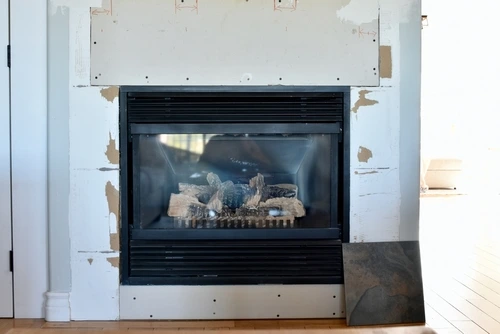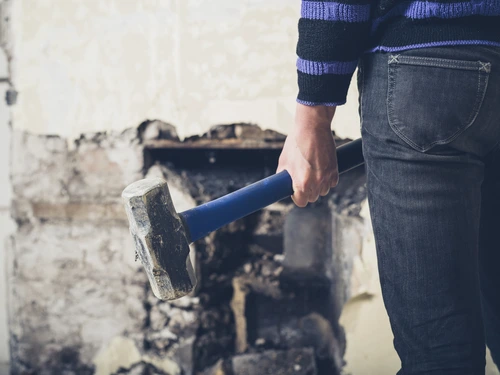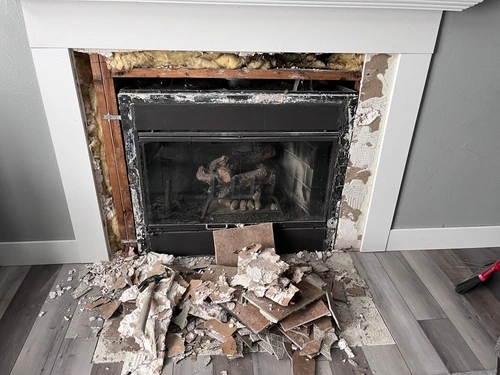Getting rid of a fireplace from your home can feel like an overwhelming task, but it can also open up space and improve the layout of your living area. For those looking to take on a DIY fireplace removal project, assessing the scope of the task and ensuring you have the necessary tools and safety measures in place is crucial. This includes considering renting a home dumpster to handle the disposal of debris effectively.
Before you start, it’s important to understand the impact on your home value. Fireplaces can be a sought-after feature in real estate, and while removing one might modernize your space, it could also affect your property value. Evaluating this trade-off is essential to make an informed decision.
The actual process of removing a fireplace involves several steps, from plugging the flue to dismantling and disposing of the bricks. Hiring a professional can ensure the job is done safely and correctly, but if you go the DIY route, detailed preparation and attention to safety are non-negotiable.
 Removing a fireplace involves careful demolition techniques and safe handling of gas and electrical components. Each step must be executed with precision to ensure both efficiency and safety.
Removing a fireplace involves careful demolition techniques and safe handling of gas and electrical components. Each step must be executed with precision to ensure both efficiency and safety.
 When getting rid of a fireplace, you need to factor in both the financial costs and the potential impact on your property value. Each subsection explores these aspects in more detail, providing crucial insights.
When getting rid of a fireplace, you need to factor in both the financial costs and the potential impact on your property value. Each subsection explores these aspects in more detail, providing crucial insights.
Key Takeaways
- Assess the impact on home value before removing a fireplace.
- Proper preparation and safety measures are crucial for a DIY project.
- Consider using a home dumpster rental for debris disposal.
Assessing the Fireplace Removal Project
Removing a fireplace from your home requires careful analysis of its structural implications and understanding the type of fireplace you have. These steps ensure safety and proper planning for the entire removal process.Evaluating Structural Implications
One crucial aspect of removing your fireplace is assessing the structural impact on your home. Start by determining if the wall containing the fireplace is a load-bearing wall. Removing a load-bearing wall without proper support can compromise your home’s structural integrity. Consulting a structural engineer is advisable. They will evaluate whether additional support beams or columns are needed during the removal process. This step is necessary to maintain the balance and safety of your home. Check the connection points where the fireplace meets other structures like the chimney breast and surrounding walls. These connections might require specific disassembly techniques. Use tools like a level to ensure that everything remains even and stable during the removal.Determining the Type of Fireplace
Identifying the type of fireplace in your home impacts the methods and tools you’ll need for removal. Different types like wood-burning, gas, or electric fireplaces have distinct removal procedures.- Wood-burning fireplaces often consist of heavy materials like bricks or stone, requiring more labor-intensive work. You will also have a chimney to deal with, which might need capping off.
- Gas fireplaces involve additional steps such as disconnecting gas lines. Ensuring that a professional handles the gas line disconnection is critical for safety.
- Electric fireplaces are the simplest to remove, often requiring just a disconnection from electrical outlets.
Preparation and Safety Measures
Proper preparation is crucial when removing a fireplace. This includes securing any necessary permits, and ensuring you have the right safety equipment and tools to perform the task efficiently and safely.Securing Necessary Permits
Before you begin, you must secure the appropriate permits. Fireplaces are often integrated into the structural elements of your home. Local building regulations may require a permit for significant alterations. Consult your local building authority to understand the specific requirements. Permits ensure compliance with safety standards and verify that your project won’t compromise the structural integrity of your home. Hiring a qualified mason or contractor can also assist in navigating the regulations and permit acquisition process.Safety Equipment and Tools
Safety is paramount during fireplace removal. Equip yourself with the necessary safety gear and tools. Start with work gloves and protective eyewear to safeguard against debris. A dust mask or respirator ensures you won’t inhale harmful particles. Tools essential for the task include a sledgehammer for breaking down the masonry, a tape measure for precise measurements, a sturdy ladder for reaching high places, and a driveway dumpster rental for the trash and debris. Ensure your workspace is well-ventilated to avoid inhaling dust and fumes. Utilizing the correct tools and safety equipment can significantly reduce the risk of accidents and injuries during the disassembly process. By following these preparation and safety measures, you’re setting a solid foundation for a successful fireplace removal.The Removal Process
 Removing a fireplace involves careful demolition techniques and safe handling of gas and electrical components. Each step must be executed with precision to ensure both efficiency and safety.
Removing a fireplace involves careful demolition techniques and safe handling of gas and electrical components. Each step must be executed with precision to ensure both efficiency and safety.
Fireplace Demolition Techniques
Begin by protecting the surrounding area. Cover nearby walls and floors with plywood or plastic sheeting to prevent damage. If you have a brick fireplace, you will need tools like a chisel, hammer, and possibly a sledgehammer. Carefully remove the mantel and any trim by prying them away from the wall. Demolish the exterior structure of the fireplace, starting from the top and working your way down. For a brick fireplace, use a chisel and hammer to carefully remove each brick. If your fireplace is built into the wall, you may need to cut through drywall or other materials. For the firebox, remove it by detaching it from its frame, making sure to not damage the surrounding area. Always dispose of debris promptly and safely to keep your workspace clear.Handling Gas and Electrical Components
Ensure you turn off the gas supply first. Locate the gas line connected to your fireplace and shut off the gas valve. Next, detach the gas lines. Working with gas pipes requires caution; consider hiring a contractor if you’re not experienced. Always use adjustable wrenches to disconnect gas fittings. Electrical components also need careful handling. Turn off power at the circuit breaker before disconnecting any wires. Remove any electrical fixtures, such as switches or blowers, that are part of the fireplace system. Use insulated tools to safely disconnect and cap any exposed wires. Double-check that both the gas and power supplies are securely turned off before proceeding with the rest of the removal process. Following these safety protocols will help prevent accidents and ensure a smooth fireplace removal. For additional guidance and detailed steps, consult resources like this step-by-step guide for safe disassembly.Finishing the Space
Transforming the area where a fireplace once stood requires careful attention to both structural integrity and visual appeal. This includes repairing any gaps left behind, ensuring proper ventilation, and adding aesthetic elements to blend seamlessly with your home’s design.Repairing and Reconstructing Walls
First, address the gaps left by the fireplace removal by installing new drywall. Ensure the framework is properly stabilized to support the new wall structure. Use drywall screws to secure the panels and apply joint compound to the seams for a smooth finish. Consider the climate of your home when choosing materials; in humid areas, moisture-resistant drywall may be necessary. Check for any hidden damage like mold or weakened studs and replace them to maintain stability. Ensure proper ventilation, especially if the fireplace served as a vent passage. If the original fireplace had air vents or ducts, seal them appropriately or reroute them to maintain airflow in the room.Aesthetic Considerations
Once structural repairs are complete, focus on making the space visually appealing. If a decorative fireplace is part of your design plan, select materials that complement your existing decor. Choose a stylish mantle or surround to add character without the need for actual fire. Adding trim around the edges where the new wall meets the existing structure can create a seamless transition. Paint or wallpaper the newly constructed area to match the surrounding walls. Consider additional decorative elements like shelving, artwork, or an entertainment center. These items can fill the visual void and add functional space, making the area both attractive and useful.Cost and Value Considerations
 When getting rid of a fireplace, you need to factor in both the financial costs and the potential impact on your property value. Each subsection explores these aspects in more detail, providing crucial insights.
When getting rid of a fireplace, you need to factor in both the financial costs and the potential impact on your property value. Each subsection explores these aspects in more detail, providing crucial insights.
Calculating the Cost of Removal
The cost of removing a fireplace can vary widely, typically ranging from $4,000 to $6,000 for a complete removal. Factors influencing the budget include the type, size, and condition of the fireplace. For instance, removing a large brick or stone chimney can cost anywhere from $4,000 to $10,000. Additional costs may be incurred for structural support and home repairs. A partial removal, such as for a gas insert or wood-burning stove, tends to be less expensive, averaging between $500 and $2,500. Understanding these costs will help you set a realistic budget for your renovation project.Understanding the Impact on Property Value
The impact on your home’s value largely depends on your local market conditions and buyer preferences. A fireplace can add thousands of dollars to your home value, especially in older homes or neighborhoods where fireplaces are common. However, maintenance expenses and safety concerns could make them less attractive to some buyers. Fireplace removal could affect your home value negatively if you’re in an area where fireplaces are a sought-after feature. Conversely, if your market values modern, minimalist spaces, the absence of a fireplace might enhance appeal. Always consider the preferences of potential buyers and consult with real estate professionals to gauge the impact accurately. Making an informed decision will help ensure your renovation aligns with market expectations and maintains or boosts your property’s value.Frequently Asked Questions
When getting rid of a fireplace, several essential steps, costs, and home value implications must be evaluated. Additionally, various technical and safety issues arise, particularly regarding retaining or removing the chimney and other structural components.What steps are involved in the removal of a fireplace from the home interior?
Removing a fireplace involves multiple steps. Initially, you need to disassemble the fireplace structure. You must plug the flue, typically using a chimney balloon or flue plug. The final steps include sealing the chimney at both ends and making any necessary repairs to the space.What is the average cost associated with removing a fireplace and chimney?
The average cost to remove a fireplace ranges from $4,000 to $6,000, depending on factors like the type, size, and condition. The lower range tends to be around $4,000, while complex removals can approach $6,000. Partial removals, which are less expensive, usually cost between $500 and $2,000.How does the removal of a fireplace affect a home’s value?
Removing a fireplace can have mixed impacts on your home’s value. In some cases, it might reduce appeal to buyers who desire a traditional fireplace. On the other hand, removing an outdated or non-functional fireplace could make your home more appealing by creating more usable space.What considerations must be taken into account when removing a fireplace insert?
When removing a fireplace insert, ensure you disconnect all utilities, such as gas or electricity, attached to the insert. Check for any structural components that might be affected. You also need to seal off the flue properly to prevent drafts and moisture.Can a chimney be left in place if the fireplace is removed?
Yes, the chimney can be left in place if the fireplace is removed. After removing the fireplace, it’s crucial to seal the chimney at both the top and the bottom. This helps to prevent any potential issues like drafts, water ingress, or bird nesting.What are the potential costs for covering up an existing fireplace?
Covering up an existing fireplace is usually less expensive than a full removal. The costs typically range between $500 and $2,000. Factors influencing the cost include the materials you choose for the cover-up, the extent of structural changes needed, and any customization involved.RECENT BLOGS
 A Homeowner’s Guide to Flash Flood Preparation, Cleanup, and Long-Term Protection
A Homeowner’s Guide to Flash Flood Preparation, Cleanup, and Long-Term Protection
Date: May 27 ,2025
 Everything You Need to Know About Garbage Bin Rental: Sizes, Costs, and Practical Tips for Every Project
Everything You Need to Know About Garbage Bin Rental: Sizes, Costs, and Practical Tips for Every Project
Date: May 14 ,2025
 Safe Disposal Methods for Refrigerators: Recycling, Donation, and Removal Options
Safe Disposal Methods for Refrigerators: Recycling, Donation, and Removal Options
Date: April 29 ,2025
Our Reviews
LATEST BLOGS








